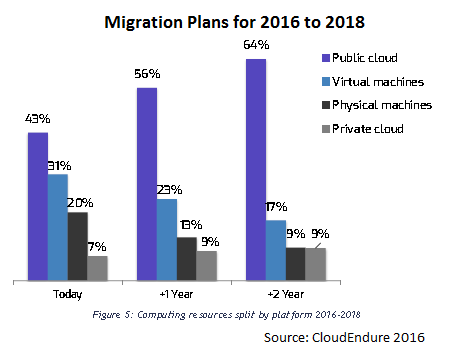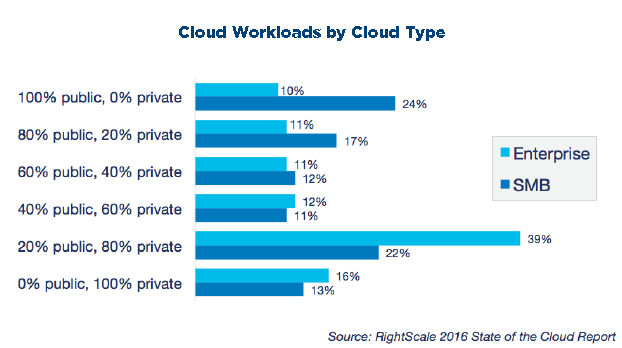The trends in Public, Private, and Hybrid Cloud: Which is right for you?

Organizations are rapidly migrating to the cloud. According to the 2016 Cloud Migration Survey, the top reasons for the cloud rush are the promise of high availability, reliability and potential cost savings. Companies, however, are not taking a one-size fits all approach. They are recognizing the pros and cons of private versus public cloud and tailoring their migration strategies to meet their needs.
 The RightScale 2016 State of the Cloud Report, which includes responses from over one thousand technical professionals, notes that private cloud adoption by organizations will rise from 63 percent in 2015 to 77 percent in 2016. Because more companies are adding private cloud to their environments, it opens up the possibilities for hybrid cloud. Seventy-one percent of them now operate in a hybrid cloud environment which enables them to combine the benefits of both public and private platforms.
The RightScale 2016 State of the Cloud Report, which includes responses from over one thousand technical professionals, notes that private cloud adoption by organizations will rise from 63 percent in 2015 to 77 percent in 2016. Because more companies are adding private cloud to their environments, it opens up the possibilities for hybrid cloud. Seventy-one percent of them now operate in a hybrid cloud environment which enables them to combine the benefits of both public and private platforms.
While the number of organizations moving to the public cloud is slowing, those that have already staked out a position continue to grow the workloads they accommodate in multi-tenant environments.
In fact, from 2016 to 2018, IT professionals expect their usage of public clouds to grow from 43 to 64 percent of their total computing resources.
During the same period, private cloud will grow from 7 to 9 percent of computing resources.
Why Hybrid Cloud Is Gaining Popularity
There is good reason for the increasing popularity of the hybrid cloud environments. Hybrid cloud provides the flexibility to place workloads in the environments that best suit them. By combining public and private cloud services, companies can maximize the benefits they derive from cloud migration.
Private cloud offers greater assurance of security, compliance and control. If organizations are in highly regulated industries, such as healthcare and financial, having their own space in the cloud makes sense. Another critical consideration is performance. In the multi-tenanted environment, performance may not be as reliable. It can degrade as a cloud service provider adds more clients or their clients’ computing demands increase. So IT leaders often opt for the private cloud for housing mission critical applications.
By having dedicated resources, however, companies are less likely to derive cost savings from their cloud migration initiative. That’s because if organizations share resources, cloud services providers can move workloads as necessary to accommodate demand. By doing so, they minimize their costs and can pass on the savings to their customers. Also, public cloud allows companies to rapidly scale the services they receive based on their needs.
Thus, organizations are aligning their cloud architectures to gain the control and performance that only dedicated resources can offer while blending in public cloud services to help meet financial goals. Companies may opt to have resources on private clouds, but to use public facilities to handle unpredictable business whose demands may require them to scale their data resources rapidly. This includes accommodating, for example, new business ventures and the peak loads that might occur for retail operations during the holiday season. The blended architecture gives them the best of both worlds.
How Company Size Affects Cloud Structure
Enterprise organizations are more likely to run their workloads in private environments than small and medium-size businesses (SMBs). The majority (55 percent) of enterprises operate in a cloud environment that is 80 percent or more private. The same is true for only 35 percent of SMBs.
Given that enterprises are less likely to realize the costs savings offered by the economies of scale of the public cloud, this finding is not surprising. That’s because they are large enough to create economies of scale internally.
Creating Your Strategy for Cloud Migration
Clearly, there is no plain vanilla approach to cloud migration. You should design your cloud architecture based on your security, compliance, performance, cost requirements and company size. Creating your strategy starts with monitoring your environment to understand your baseline profiles of utilization, CPU capacity, and I/O performance. Combine these requirements with your needs for security, compliance, control, scalability and cost savings. Factor in all these elements to make decisions that maximize the benefits of your cloud migration.
Photo Credit: Stokkete/Shutterstock
 As Co-Founder and Principal of ATS Group and the Galileo Division, Chris Churchey brings over 35 years of IT experience in enterprise open systems and storage technologies -- with an emphasis on operating systems, virtualization, large scale systems/storage architecting, design and integration, and performance optimization of computer resources. Chris holds numerous IBM Certifications and is a subject matter expert (SME) in Server/Storage Consolidation, Performance, AIX, Linux, Power, Virtualization, and IBM Storage technologies. In his current role, Chris oversees business development and the management and support of large/direct ATS customers.
As Co-Founder and Principal of ATS Group and the Galileo Division, Chris Churchey brings over 35 years of IT experience in enterprise open systems and storage technologies -- with an emphasis on operating systems, virtualization, large scale systems/storage architecting, design and integration, and performance optimization of computer resources. Chris holds numerous IBM Certifications and is a subject matter expert (SME) in Server/Storage Consolidation, Performance, AIX, Linux, Power, Virtualization, and IBM Storage technologies. In his current role, Chris oversees business development and the management and support of large/direct ATS customers.